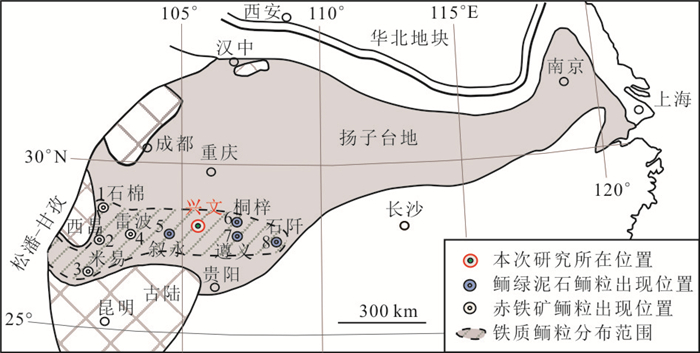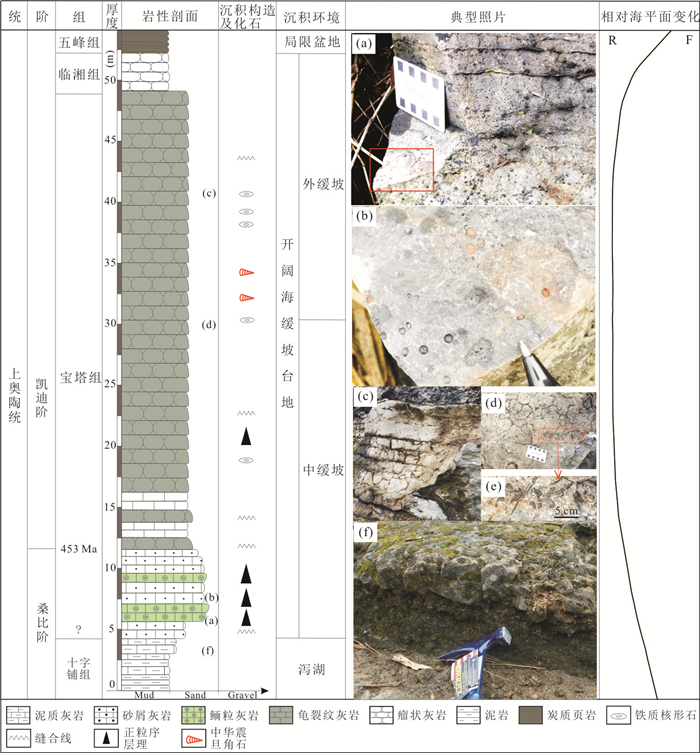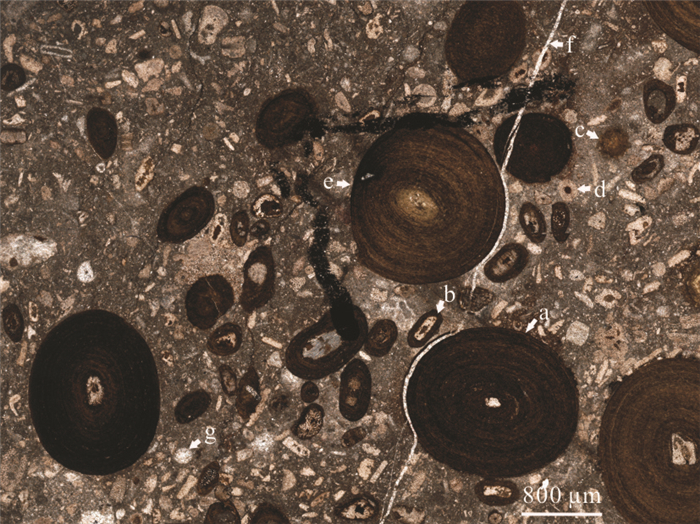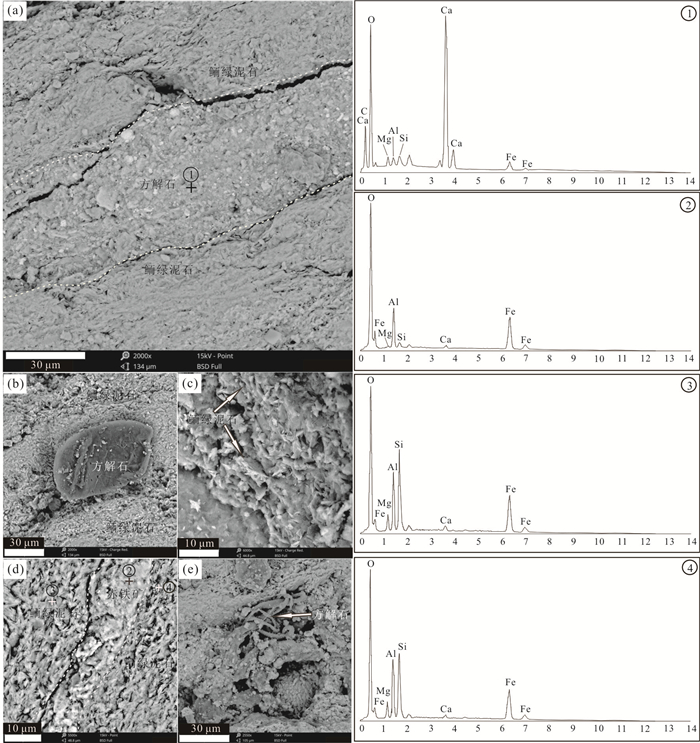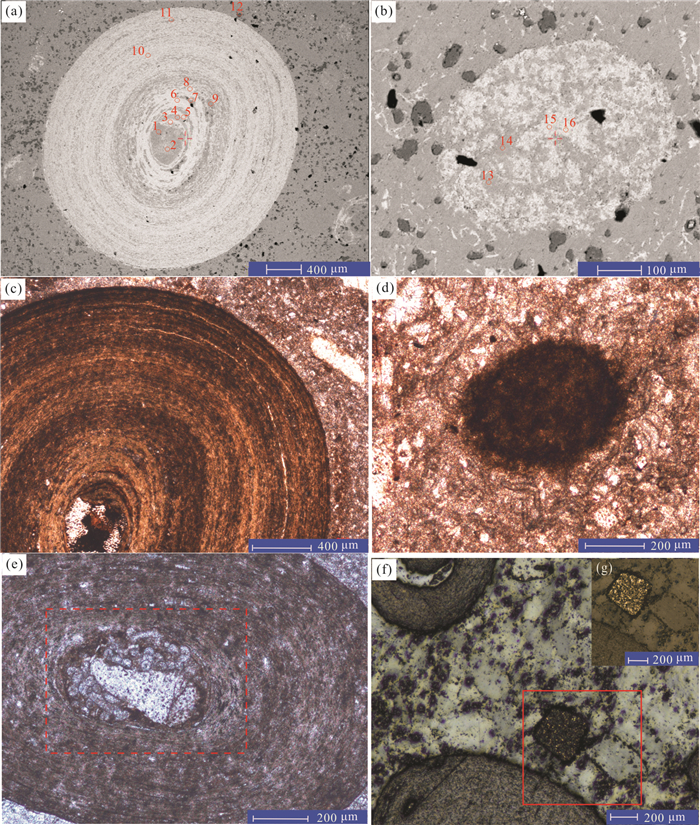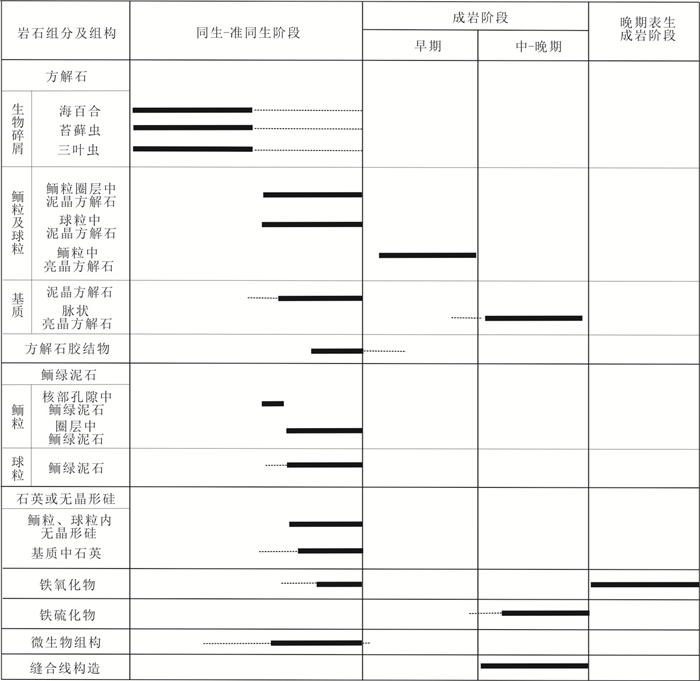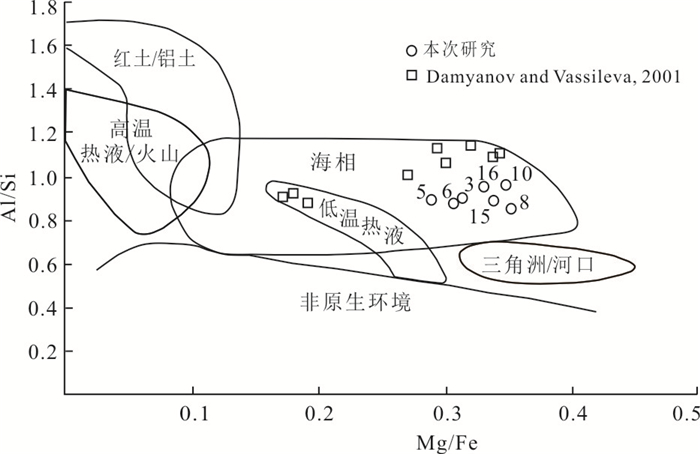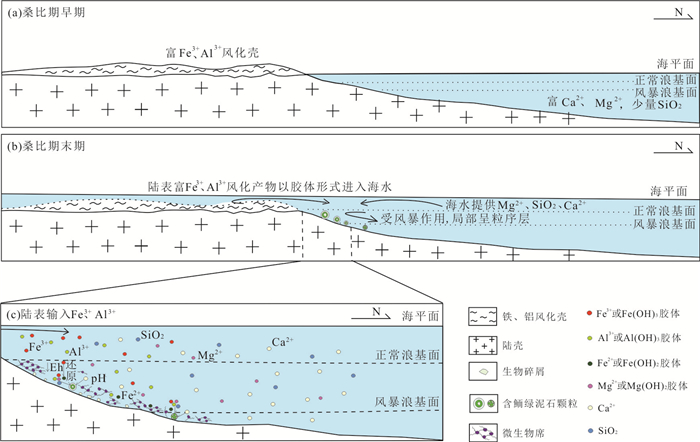Chamosite-Ooidal Limestones at the Bottom of Ordovician Pagoda Formation in the Southwestern Yangtze Platform: Genesis and Paleoenvironmental Implications
-
摘要: 对四川省兴文县上奥陶统宝塔组底部含鲕绿泥石灰岩开展成因研究,有助于了解扬子台地西南部同时期的沉积环境演化过程.通过沉积学分析,并辅助以电子探针和扫描电镜等矿物学研究方法,发现富鲕绿泥石鲕粒及球粒为同生期沉积物,共生的生物碎屑组合指示海水为氧化性水体.丰富的微生物相关组构表明同期微生物席发育,且其代谢活动可致使水岩界面附近形成还原性水体,这是同生鲕绿泥石形成的必要条件,鲕绿泥石形成所需的Fe、Al元素来自早期风化壳在海侵阶段的大规模输入.宝塔组底部富鲕绿泥石灰岩是同期全球海平面演化在扬子台地的具体表现,佐证了早桑比期的海平面下降,是晚桑比期扬子台地快速海侵的重要标志.Abstract: A set of the chamosite-ooidal limestones was discovered at the bottom of the Pagoda Formation (Upper Ordovician) in Xingwen County, Sichuan Province, and its genesis can facilitate the understanding the evolution of the depositional environment in the southwestern Yangtze platform during the same period. Based on a detailed sedimentological analysis, this paper presents a study on the genesis of the chamosite-ooidal limestones, combined with mineralogical characterization via electron microprobe and scanning electron microscope studies. It is found that chamosite-rich ooids and peloids are syngenetic sediments, and symbiotic bioclastic assemblages indicate that the seawater was oxidizing. The abundant microbial-related fabric indicates that microbial mats develop during the same period, and their metabolic activities can lead to the formation of reducing water bodies near the water-sediment interface, which is a necessary condition for the formation of syngenetic chamosite. The Fe and Al elements needed for chamosite formation are derived from large-scale inputs of the early weathering crust during the transgression stage. The chamosite-ooidal limestones at the bottom of the Pagoda Formation are the concrete manifestation of global sea-level evolution in the Yangtze platform at same time. It is an important indicator of sea level fall in the Early Sandbian and rapid transgression in the Late Sandbian in the Yangtze platform.
-
Key words:
- Yangtze platform /
- Pagoda Formation /
- chamosite ooids /
- microbial /
- sea-level change /
- sedimentology
-
图 1 扬子台地中‒上奥陶统主要岩石地层单位对比
据汪啸风(2016)、苏文博等(1999);R. 海平面上升;F. 海平面下降
Fig. 1. Correlation of litho-stratigraphic units in the Middle-Upper Ordovician of Yangtze platform
图 2 桑比期‒早凯迪期华南扬子地块古地理格架
据陈旭等(1990)、Chen et al.(2010)修改;图 2显示的晚奥陶纪铁质鲕粒分布的地理位置沈健伟(1994)
Fig. 2. Paleogeographic framework of the Yangtze block, South of China in the Sanbian-Early Katian Stage
图 5 鲕粒圈层SEM背散射图像及能谱曲线
a. 为鲕粒圈层中片状鲕绿泥石与泥晶方解石的互层结构;b. 为少量方解石后期重结晶充填于鲕绿泥石圈层孔隙中;c. 为鲕粒圈层中的鲕绿泥石呈片状沿鲕粒圈层切线方向排列;d. 鲕粒圈层中的部分鲕绿泥石转化为赤铁矿;e.为蓝细菌钙化现象.①、②、③、④分别为图 5a和图 5d中对应测点的能谱曲线;①指示主要矿物为方解石;②指示主要矿物为赤铁矿,但其中的Al峰值表明原生鲕绿泥石转化为赤铁矿后残余的富铝矿物;③和④指示主要矿物为鲕绿泥石;“+”为测点位置
Fig. 5. BSE images and energy spectrum curves of cortical layers in ooid by SEM
图 8 基于Mg/Fe vs. Al/Si化学成分对比判别鲕绿泥石形成地质环境
据Damyanov and Vassileva(2001)修改
Fig. 8. Mg/Fe vs. Al/Si bivariate plots of chamosites from different geological settings
图 9 扬子台地西南缘桑比期沉积环境变化及鲕绿泥石鲕粒形成过程
a.桑比期早期低水位导致古陆暴露并形成富Fe、Al风化壳,为鲕绿泥石形成准备了重要物质基础;b.桑比期末期海侵导致水平面上升,古陆及风化壳被海水淹没并搬运Fe、Al质到浅海水域中;c.鲕绿泥石鲕粒形成过程模式图,在海水富Fe、Al背景下,微生物席发育为海水‒沉积物界面提供还原水体环境,从而导致鲕绿泥石结晶沉淀
Fig. 9. Evolution of sedimentary environment related to the formation of the chamosite ooidal limestones in Sandbian in southwest margin of Yangtze platform
表 1 铁质颗粒中各矿物成分电子探针分析结果(%)
Table 1. Chemical analytical results (%) of mineral components in iron particles
测点 1 2 3 4 5 6 7 8 9 10 11 12 13 14 15 16 SiO2 0.288 0.044 23.233 0.624 22.825 23.375 0.257 22.745 0.042 23.714 0.083 93.200 1.011 0.211 21.196 22.085 TiO2 bdl bdl 0.667 0.441 0.237 0.361 0.186 0.199 0.207 0.047 0.037 0.075 0.130 0.106 0.052 0.064 SrO 0.075 bdl 0.056 0.161 bdl 0.022 0.053 0.072 0.047 0.021 0.064 0.105 0.002 0.048 0.007 bdl Cr2O3 0.003 0.015 bdl 0.039 0.009 bdl 0.004 0.031 bdl 0.008 bdl bdl bdl bdl 0.022 0.022 MgO 0.933 0.885 6.289 0.356 5.850 6.221 0.663 6.151 0.492 6.617 0.751 0.012 0.854 0.936 6.135 6.390 P2O5 0.099 0.032 bdl 0.065 bdl bdl 0.017 0.057 0.035 0.009 0.090 bdl 0.011 0.035 bdl bdl MnO 0.017 0.030 0.070 0.144 bdl 0.021 0.094 0.019 0.133 bdl 0.096 bdl 0.131 0.155 0.005 0.002 Al2O3 0.006 bdl 17.795 0.409 17.314 17.412 0.105 16.471 0.054 19.366 0.010 0.006 0.711 0.181 15.916 17.799 SO3 0.018 0.049 bdl 0.004 0.006 bdl 0.063 bdl 0.065 0.015 0.029 bdl 0.099 0.125 0.027 0.030 FeO 0.249 0.317 35.913 7.187 36.250 36.337 1.633 31.268 0.749 34.037 0.371 0.083 2.958 3.030 32.416 34.515 K2O 0.053 0.149 0.079 0.009 0.032 0.046 0.002 0.090 bdl 0.038 0.001 bdl 0.018 0.014 0.093 0.090 CaO 52.055 53.414 0.291 45.987 0.119 0.190 55.078 4.789 56.866 0.229 52.930 0.223 49.928 51.611 7.733 2.699 BaO bdl 0.001 bdl bdl 0.037 0.006 0.017 bdl 0.015 0.017 0.063 bdl bdl bdl bdl bdl Na2O 0.038 0.025 0.033 0.026 0.054 0.046 0.016 0.043 0.019 0.072 0.012 0.059 bdl 0.065 0.018 0.049 Total 53.861 54.961 84.427 55.452 83.125 84.036 58.186 81.935 58.725 84.189 54.537 93.761 55.853 56.517 83.620 83.745 注:测点3、5、6、8、10、15、16为鲕绿泥石,1、2、4、7、9、11、13、14为方解石,12为石英;FeO代表全铁;bdl代表低于检测限. 表 2 鲕绿泥石原子比例计算结果
Table 2. Calculated atomic ratios of chamosites in this study
测点 3 5 6 8 10 15 16 Si 2.738 2.758 2.772 2.757 2.756 2.575 2.639 ⅣAl+ⅥAl 2.471 2.466 2.434 2.353 2.653 2.279 2.507 Fe 3.541 3.665 3.606 3.172 3.311 3.295 3.452 Mg 1.105 1.054 1.100 1.111 1.147 1.111 1.138 Mg/Fe 0.312 0.287 0.305 0.350 0.346 0.337 0.330 Al/Si 0.903 0.894 0.878 0.854 0.963 0.885 0.950 注:以28个氧原子为基础,计算鲕绿泥石的原子比例;Fe代表全铁. -
Bhattacharyya, D. P., 1983. Origin of Berthierine in Ironstones. Clays and Clay Minerals, 31(3): 173-182. https://doi.org/10.1346/CCMN.1983.0310302 Chen, X., Xu, J. T., Cheng, H. J., et al., 1990. On the Hannan Old Land and Dabashan Uplift. Journal of Stratigraphy, 14(2): 81-116 (in Chinese with English abstract). http://en.cnki.com.cn/Article_en/CJFDTOTAL-DCXZ199002000.htm Chen, X., Zhou, Z. Y., Fan, J. X., 2010. Ordovician Paleogeography and Tectonics of the Major Paleoplates of China. Special Paper of the Geological Society of America, 466: 85-104. https://doi.org/10.1130/2010.2466(06) Clement, A. M., Tackett, L. S., Ritterbush, K. A., et al., 2020. Formation and Stratigraphic Facies Distribution of Early Jurassic Iron Oolite Deposits from West Central Nevada, USA. Sedimentary Geology, 395: 105537. https://doi.org/10.1016/j.sedgeo.2019.105537 Damyanov, Z., Vassileva, M., 2001. Authigenic Phyllosilicates in the Middle Triassic Kremikovtsi Sedimentary Exhalative Siderite Iron Formation, Western Balkan, Bulgaria. Clays and Clay Minerals, 49(6): 559-585. https://doi.org/10.1346/CCMN.2001.0490607 Dodd, M. S., Papineau, D., She, Z. B., et al., 2018. Organic Remains in Late Palaeoproterozoic Granular Iron Formations and Implications for the Origin of Granules. Precambrian Research, 310: 133-152. https://doi.org/10.1016/j.precamres.2018.02.016 Fan, R., Lu, Y. Z., Zhang, X. L., et al., 2013. New Understanding of the Contact Relationship between Shihtzupu Formation and Pagoda Formation in Sichuan Basin. Acta Geologica Sinica, 87(3): 321-329 (in Chinese with English abstract). http://epub.cnki.net/grid2008/docdown/docdownload.aspx?filename=DZXE201303004&dbcode=CJFD&year=2013&dflag=pdfdown Garcia-Frank, A., Ureta, S., Mas, R., 2012. Iron-Coated Particles from Condensed Aalenian-Bajocian Deposits: Evolutionary Model (Iberian Basin, Spain). Journal of Sedimentary Research, 82(12): 953-968. https://doi.org/10.2110/jsr.2012.75 Gehring, A. U., 1989. The Formation of Goethitic Ooids in Condensed Jurassic Deposits in Northern Switzerland. Geological Society, London, Special Publications, 46(1): 133-139. https://doi.org/10.1144/gsl.sp.1989.046.01.13 Han, K. B., 2019. Characteristics and Formation Mechanism of Oolitic Ironstones in Middle Jurassic Batonian Period, in Nyalam Area, Southern Tibet (Dissertation). China University of Geosciences, Beijing (in Chinese with English abstract). Harder, H., 1978. Synthesis of Iron Layer Silicate Minerals under Natural Conditions. Clays and Clay Minerals, 26(1): 65-72. https://doi.org/10.1346/CCMN.1978.0260108 Harder, H., 1989. Mineral Genesis in Ironstones: A Model Based Upon Laboratory Experiments and Petrographic Observations. Geological Society, London, Special Publications, 46(1): 9-18. https://doi.org/10.1144/gsl.sp.1989.046.01.04 Heller, P. L., Komar, P. D., Pevear, D. R., 1980. Transport Processes in Ooid Genesis. Journal of Sedimentary Research. 50(3): 943-951. https://doi.org/10.1306/212f7b2b-2b24-11d7-8648000102c1865d Jiang, Z. X., 2003. Sedimentary Petrology. Petroleum Industry Press, Beijing (in Chinese). Kimberley, M. M., 1974. Origin of Iron Ore by Diagenetic Replacement of Calcareous Oolite. Nature, 250(5464): 319-320. https://doi.org/10.1038/250319a0 Lu, Y. B., Ma, Y. Q., Wang, Y. X., et al., 2017. The Sedimentary Response to the Major Geological Events and Lithofacies Characteristics of Wufeng Formation-Longmaxi Formation in the Upper Yangtze Area. Earth Science, 42(7): 1169-1184 (in Chinese with English abstract). http://en.cnki.com.cn/Article_en/CJFDTOTAL-DQKX201707012.htm Maynard, J. B., 1986. Geochemistry of Oolitic Iron Ores, an Electron Microprobe Study. Economic Geology, 81(6): 1473-1483. https://doi.org/10.2113/gsecongeo.81.6.1473 Mei, M. X., 2011. Microbial-Mat Sedimentology: A Young Branch from Sedimentology. Advances in Earth Science, 26(6): 586-597 (in Chinese with English abstract). http://en.cnki.com.cn/Article_en/CJFDTOTAL-DXJZ201106003.htm Mücke, A., 2006. Chamosite, Siderite and the Environmental Conditions of Their Formation in Chamosite-Type Phanerozoic Ooidal Ironstones. Ore Geology Reviews, 28(2): 235-249. https://doi.org/10.1016/j.oregeorev.2005.03.004 O'Reilly, S. S., Mariotti, G., Winter, A. R., et al., 2017. Molecular Biosignatures Reveal Common Benthic Microbial Sources of Organic Matter in Ooids and Grapestones from Pigeon Cay, the Bahamas. Geobiology, 15(1): 112-130. https://doi.org/10.1111/gbi.12196 Qin, S., Zhang, T., Su, W. B., et al., 2011. Characteristics and Implications of the Oolitic Limestones from the Silurian Succession in Wangcang, Sichuan, South China. Earth Science, 36(1): 43-52 (in Chinese with English abstract). http://en.cnki.com.cn/Article_en/CJFDTOTAL-DQKX201101006.htm Rahiminejad, A. H., Zand-Moghadam, H., 2018. Synsedimentary Formation of Ooidal Ironstone: an Example from the Jurassic Deposits of SE Central Iran. Ore Geology Reviews, 95: 238-257. https://doi.org/10.1016/j.oregeorev.2018.02.028 Rayner, D. H., Hemingway, J. E., 1974. The Geology and Mineral Resources of Yorkshire. Yorkshire Geological Society, Leeds. Salama, W., El Aref, M., Gaupp, R., 2014. Facies Analysis and Palaeoclimatic Significance of Ironstones Formed during the Eocene Greenhouse. Sedimentology, 61(6): 1594-1624. https://doi.org/10.1111/sed.12106 Scholle, P. A., Ulmer-Scholle, D. S., 2003. A Color Guide to the Petrography of Carbonate Rocks. American Association of Petroleum Geologists, McLean. Servais, T., Owen, A. W., Harper, D. A. T., et al., 2010. The Great Ordovician Biodiversification Event (GOBE): The Palaeoecological Dimension. Palaeogeography, Palaeoclimatology, Palaeoecology, 294(3-4): 99-119. https://doi.org/10.1016/j.palaeo.2010.05.031 Sharma, S., Dix, G. R, 2004. Magnesian Calcite and Chamositic Ooids Forming Shoals Peripheral to Late Ordovician (Ashgill) Muddy Siliciclastic Shores: Southern Ontario. Palaeogeography, Palaeoclimatology, Palaeoecology, 210(2-4): 347-366. https://doi.org/10.1016/j.palaeo.2004.02.036 Shen, J. W., 1994. Sequential Position and Environment Significance of Chamositic Ooids and Glauconite in the Early Middle Ordovician Sediments in Guizhou Province and Adjacent Areas. Guzhou Geology, 11(3): 207-217 (in Chinese with English abstract). http://en.cnki.com.cn/Article_en/CJFDTOTAL-GZDZ403.003.htm Siehl, A., Thein, J., 1989. Minette-Type Ironstones. Geological Society, London, Special Publications, 46(1): 175-193. https://doi.org/10.1144/gsl.sp.1989.046.01.16 Song, W. T., Liu, J. B., 2020. A Review of Cortical Structures of Carbonate Ooids. Journal of Palaeogeography, 22(1): 147-160 (in Chinese with English abstract). Sturesson, U., Heikoop, J. M., Risk, M. J., 2000. Modern and Palaeozoic Iron Ooids-A Similar Volcanic Origin. Sedimentary Geology, 136(1-2): 137-146. https://doi.org/10.1016/S0037-0738(00)00091-9 Su, W. B., Li, Z. M., Chen, J. Q., et al., 1999. A Reliable Example for Eustacy Ordovician Sequence Stratigraphy on the Southeastern Margin of the Upper Yangtze Platform. Acta Sedimentologica Sinica, 17(3): 345-353 (in Chinese with English abstract). http://en.cnki.com.cn/Article_en/CJFDTOTAL-CJXB199903002.htm Tang, D. J., Shi, X. Y., Jiang, G. Q., et al., 2017. Ferruginous Seawater Facilitates the Transformation of Glauconite to Chamosite: An Example from the Mesoproterozoic Xiamaling Formation of North China. American Mineralogist, 102(11): 2317-2332. https://doi.org/10.2138/am-2017-6136 Taylor, K. G., Simo, J. A., Yocum, D., et al., 2002. Stratigraphic Significance of Ooidal Ironstones from the Cretaceous Western Interior Seaway: The Peace River Formation, Alberta, Canada, and the Castlegate Sandstone, Utah, USA. Journal of Sedimentary Research, 72(2): 316-327. https://doi.org/10.1306/060801720316 Todd, S. E., Pufahl, P. K., Murphy, J. B., et al., 2019. Sedimentology and Oceanography of Early Ordovician Ironstone, Bell Island, Newfoundland: Ferruginous Seawater and Upwelling in the Rheic Ocean. Sedimentary Geology, 379: 1-15. https://doi.org/10.1016/j.sedgeo.2018.10.007 Tribovillard, N., Algeo, T. J., Lyons, T., et al., 2006. Trace Metals as Paleoredox and Paleoproductivity Proxies: An Update. Chemical Geology, 232(1-2): 12-32. https://doi.org/10.1016/j.chemgeo.2006.02.012 van Houten, F. B., Bhattacharyya, D. P., 1982. Phanerozoic Oolitic Ironstones: Geologic Record and Facies Model. Annual Review of Earth and Planetary Sciences, 10(1): 441-457. https://doi.org/10.1146/annurev.ea.10.050182.002301 van Houten, F. B., Purucker, M. E., 1984. Glauconitic Peloids and Chamositic Ooids-Favorable Factors, Constraints, and Problems. Earth-Science Reviews, 20(3): 211-243. https://doi.org/10.1016/0012-8252(84)90002-3 Wang, H. Z., Shi, X. Y., 1998. Hierarchy of Depositional Sequences and Eustatic Cycles a Discussion on the Mechanism of Sedimentary Cycles. Geoscience, 12(1): 1-17 (in Chinese with English abstract). Wang, X. F., 2016. Ordovician Tectonic-Paleogeography in South China and Chrono- and Bio-Stratigraphic Division and Correlation. Earth Science Frontiers, 23(6): 253-267 (in Chinese with English abstract). http://www.researchgate.net/publication/316514996_Ordovician_tectonic-paleogeography_in_South_China_and_chrono-and_bio-stratigraphic_division_and_correlation Xu, X. S., Wan, F., Yin, F. G., et al., 2001. Environment Facies, Ecological Facies and Diagenetic Facies of Baota Formation, of Late Ordovina. Journal of Mineralogy and Petrology, 21(3): 64-68 (in Chinese with English abstract). http://en.cnki.com.cn/Article_en/CJFDTotal-KWYS200103009.htm Young, T. P., 1989. Phanerozoic Ironstones: An Introduction and Review. Geological Society, London, Special Publications, 46(1): ⅸ-xxv. https://doi.org/10.1144/gsl.sp.1989.046.01.02 陈旭, 徐均涛, 成汉钧, 等, 1990. 论汉南古陆及大巴山隆起. 地层学杂志, 14(2): 81-116. https://www.cnki.com.cn/Article/CJFDTOTAL-DCXZ199002000.htm 樊茹, 卢远征, 张学磊, 等, 2013. 四川盆地奥陶系十字铺组与宝塔组接触关系新认识. 地质学报, 87(3): 321-329. doi: 10.3969/j.issn.0001-5717.2013.03.003 韩凯博, 2019. 藏南聂拉木地区中侏罗世巴通期铁鲕岩的特征及形成机制(硕士学位论文). 北京: 中国地质大学. 姜在兴, 2003. 沉积岩石学. 北京:石油工业出版社. 陆扬博, 马义权, 王雨轩, 等, 2017. 上扬子地区五峰组-龙马溪组主要地质事件及岩相沉积响应. 地球科学, 42(7): 1169-1184. doi: 10.3799/dqkx.2017.095 梅冥相, 2011. 微生物席沉积学: 一个年轻的沉积学分支. 地球科学进展, 26(6): 586-597. https://www.cnki.com.cn/Article/CJFDTOTAL-DXJZ201106003.htm 秦松, 张涛, 苏文博, 等, 2011. 四川旺苍志留系鲕粒灰岩特征及地质意义. 地球科学, 36(1): 43-52. doi: 10.3799/dqkx.2011.005 沈健伟, 1994. 贵州及邻区中奥陶世早期沉积物中鲕绿泥石鲕和海绿石的时序位置和环境意义. 贵州地质, 11(3): 207-217. https://www.cnki.com.cn/Article/CJFDTOTAL-GZDZ403.003.htm 宋文天, 刘建波, 2020. 碳酸盐鲕粒包壳结构研究综述. 古地理学报, 22(1): 147-160. https://www.cnki.com.cn/Article/CJFDTOTAL-GDLX202001009.htm 苏文博, 李志明, 陈建强, 等, 1999. 海平面变化全球可比性的可靠例证: 上扬子地台东南缘奥陶纪层序地层及海平面变化研究. 沉积学报, 17(3): 345-353. https://www.cnki.com.cn/Article/CJFDTOTAL-CJXB199903002.htm 王鸿祯, 史晓颖, 1998. 沉积层序及海平面旋回的分类级别: 旋回周期的成因讨论. 现代地质, 12(1): 1-17. https://www.cnki.com.cn/Article/CJFDTOTAL-XDDZ801.000.htm 汪啸风, 2016. 中国南方奥陶纪构造古地理及年代与生物地层的划分与对比. 地学前缘, 23(6): 253-267. https://www.cnki.com.cn/Article/CJFDTOTAL-DXQY201606026.htm 许效松, 万方, 尹福光, 等, 2001. 奥陶系宝塔组灰岩的环境相、生态相与成岩相. 矿物岩石, 21(3): 64-68. https://www.cnki.com.cn/Article/CJFDTOTAL-KWYS200103009.htm -









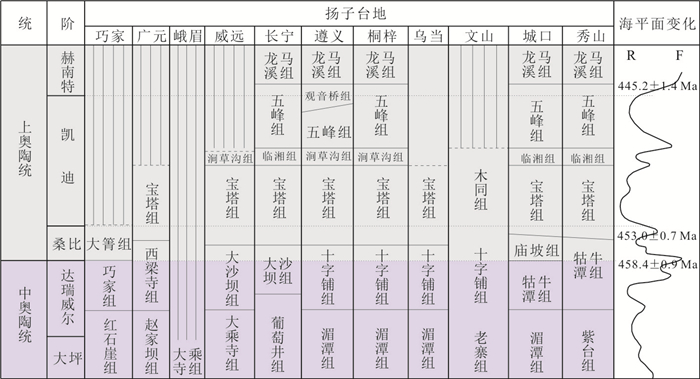
 下载:
下载:
